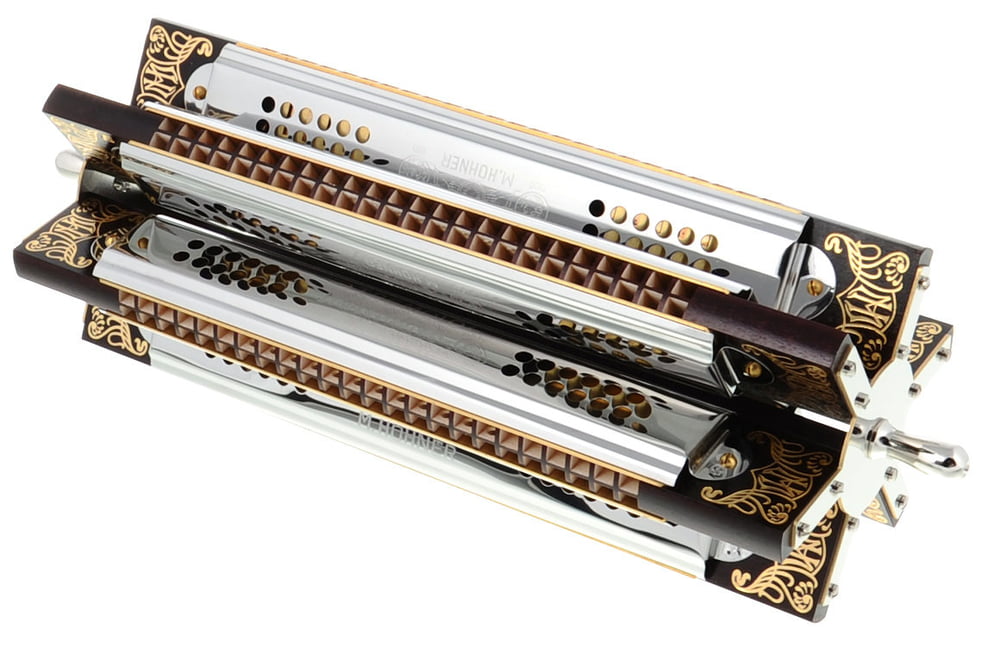3. Harmonica Types
Richter Harmonicas - the Blues Harp

Richter diatonic harmonica - the blues harp
Not much is known about Herr Richter - not even his first name - though he is thought to have come from what is now known as the Czech Republic. Nevertheless, we owe him a great debt for creating a simple but enormously versatile type of harmonica. Blow notes are set in the upper reed plates, draw notes in the lower. Each hole has a blow note and a draw note. The most common Richter diatonics have ten holes. Yet far from being limited to a mere 20 notes, players like Howard Levy have found ways to extract a full 37 different notes from a single Richter harp. And the great bluesmen managed to find notes never heard in Western music, laying the foundations of modern popular music with instruments that often cost no more than 50 cents.
Beginner and Melody Harmonicas
Typically, these instruments have combs with two rows of holes, with each hole having blow and draw reeds. They have full diatonic scales in each register. They produce sweet tones and it is easy to play simple tunes - ideal for beginners.
Chromatic Harmonicas

Hohner Chromonica 270/48 C- Deluxe
A chromatic harmonica is essentially two Melody-style diatonic harps placed one on top of the other. However, the lower of the two is tuned a semitone higher, allowing you to play full chromatic scales without having to bend notes. On most chromatics, the lower channel is blocked by a spring-loaded slider, which you press when you want to play the notes of the higher-tuned harp.
Viennese Harmonicas

Hohner Unsere Lieblinge 32
Also known as a Thie harmonica - after its creator, Wilhelm Thie - this type of harmonica uses the usual diatonic sequence of notes, but the reed plates are constructed differently. Both the upper and lower reed plates have blow reeds and draw reeds, separated by the divider in the comb. Each hole therefore only produces one note - blow, or draw. Most Viennese harps have the same notes in the upper and lower holes, so you get a rich double tone.
Half Viennese
Simply, a Viennese harmonica with only one reed plate.
Tremolo Harmonicas

Hohner Echo Harp - 96 voices
Often using the Viennese design, these harmonicas add a twist by tuning the lower reed plates slightly differently to the upper reed plates. This gives a subtle harmonic vibration that adds a sweet resonance to the tones.
Octave Harmonicas

C.A. Seydel Söhne Club 40 Oktav
A variation on the Tremolo theme, Octave harmonicas have the plates tuned an octave apart, again leading to rich harmonic overtones.
Wender and Kreuzwender

Hohner Kreuzwender
On a Wender harmonica, you effectively have a pair of harmonicas back-to-back. Typically, you'll have a C and a G, a D and an A, or a Bb with an F. The idea is that you can switch the harmonica round to find notes not usually available on a standard diatonic, which is only tuned to one key. Kreuzwender Harmonicas go even further by linking several harmonicas in a star-configuration (kreuz = star). The result is an ungainly but highly versatile instrument.
Knittlinger Harmonicas

C.A. Seydel Söhne Concerto Solo Oktav
Similar to the Viennese Harmonica, the main difference with a Knittlinger is that the blow/draw pairs in each hole are not divided. Thus the holes are rectangular and a slightly more subtle technique is required to ensure smooth playing.
Special Tunings
SBS - the Steve Baker Special
Harp-ace Steve Baker is a consultant to Hohner and developed this extended version of the Marine Band with them. There are three extra holes in the lower octave - giving some rich, fruity bends - and an extra hole at the top. Note also that Steve Baker wrote the bible for harmonica players - The Harp Handbook. Its essential reading.
Country Tuning
A variation of Richter tuning, the draw on the fifth hole is raised by a semitone. This makes the harp easier to use for musical styles where the blue-note is less appropriate, such as country, folk or latin.
Cross Chromatic and Slide Harp
So-called cross chromatic harmonicas use the Richter configuration, which means that true chromatic playing - with every note available without bending - is not possible. The slide harp uses a slightly different layout; instead of opening and closing the lower row of holes, the slide opens and closes the upper and lower parts of each hole. Its a design that makes bending a little easier.
Orchestra/Ensemble Models
Bass Harmonicas
These mighty instruments produce magnificent tones and are the essential foundation of harmonica bands. They are laid out like the keys of a piano, with the natural scale on the lower reed plates and the sharps and flats on the upper reed plate. This leaves some of the upper holes free - there are fewer sharps and flats - so additional F and B notes are added.
Chord Harmonicas

Hohner Chord 48
As the name suggests, these are harmonicas designed to allow chords to be played easily. Major, minor, seventh, augmented and diminished chords can be played. Instruments such as the Hohner Chord - which measures almost two feet in length and has 384 tones - create huge sounds, though they require considerable skill (and puff) to play.










